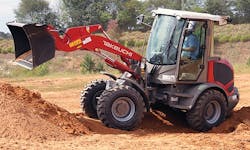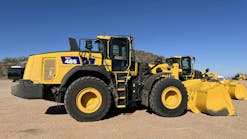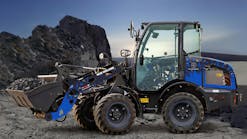As a manufacturer of compact wheel loaders, Takeuchi suggests a proactive approach to maintenance, from daily inspections to regular hours-based preventive maintenance. Keith Kramlich, national service and warranty manager, suggests that the best place for information is the operator’s or service manual.
Daily loader checks
A visual walk-around, before the machine is started up for work, should include ensuring debris is cleared from areas such as the radiator, air conditioner condenser, and exhaust. Other checks:
- Search for visible oil leaks.
- If applicable, drain the fuel and water separator.
- Look at tire pressure and condition. Punctures or gouges, metal showing, or inadequate tread depths are all signs of poor tire condition.
- All vital fluid levels should be checked and refilled if necessary, including engine oil, engine coolant, hydraulic oil, fuel, and windshield washer fluid.
- Ensure all driving and warning lights are functional.
- Takeuchi also recommends daily greasing of all pivot points and the articulation point. For safety purposes, the operator should clean the mirrors and windows, and ensure that the brakes are functional and the backup alarm is working.
Weekly checks
Takeuchi recommends certain maintenance tasks be completed every 100 hours of operation, or approximately once a week. Those tasks include:
- Thoroughly greasing the pivot points, bushing, and bearing.
- Check the lug nuts on each tire and tighten to the appropriate torque.
- Inspect electrical connections, cables, and plugs.
- Clean and securely attach the battery contacts.
- Check for blown fuses or loose connections in the fuse panel.
- If dirty, clean the radiator and oil cooler from the inside out with compressed air or high-pressure water. However, tread carefully to avoid damaging anything in the process.
- If necessary, clean and replace the engine air filter. This is especially true for operators working in dusty environments like demolition applications. Do not use high-pressure compressed air to clean the air filter or hit it against anything, as this can result in damage.
Preventive maintenance tasks are tied to the machine usage, measured by hours.
At 250 hours
- The engine oil and fuel filters are often require changing.
- The oil level in the front and rear axles, power divider, and all four planetary drives should be checked.
At 500 hours
- The oil in the front and rear axles, power divider, and all four planetary drives should be changed within the initial 500 hours. Following the initial period, these will only need to be replaced every 1,500 hours.
- Replace axle breathers.
- Check battery posts for corrosion and clean if necessary.
At 1,500 hours
- Replace oil in the axles, power divider, and planetary drives.
- Change the hydraulic oil.
- Service the brake system.
At 3,000 hours
- Replace the hydraulic oil, air filters, and breathers.
- Ensure all bolts and screws are tightened to the proper torque specifications.
- Inspect hydraulic hoses for fatigue, cracking, or leaks, and replace if necessary.
Tips for engines
A diesel engine will probably require more occasional maintenance, including fluid changes, valve train adjustments, and fuel and exhaust system checks.
Kramlich suggests that turbo-equipped engines be allowed to warm up and cool down. Allow the engine time to warm up prior to putting the machine under a load, and let it cool down before completely shutting it off. Although allowing a Tier 4-F engine to idle continuously can cause regeneration issues, a few minutes to heat up at the beginning and cool down at the end of a shift is harmless and will prevent premature turbo failures or engine damage.
Source: Takeuchi





